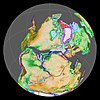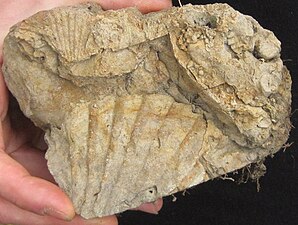Chipaque Formation
| Chipaque Formation | |
|---|---|
| Stratigraphic range: Cenomanian-Turonian ~ | |
| Type | Geological formation |
| Unit of | Villeta Group |
| Underlies | Guadalupe Gp Arenisca Dura Fm |
| Overlies | Une Formation |
| Thickness | up to 1,700 metres (5,580 ft) |
| Lithology | |
| Primary | Organic shale |
| Other | Sandstone, limestone, siltstone |
| Location | |
| Coordinates | 4°27′07″N 74°03′20″W / 4.45194°N 74.05556°W |
| Region | Altiplano Cundiboyacense Eastern Ranges, Andes |
| Country | |
| Type section | |
| Named for | Chipaque |
| Named by | Hubach |
| Location | Chipaque |
| Year defined | 1957 |
| Coordinates | 4°27′07″N 74°03′20″W / 4.45194°N 74.05556°W |
| Region | Cundinamarca, Boyacá |
| Country | |
| Thickness at type section | 1,027 metres (3,370 ft) |
 Paleogeography of Northern South America 90 Ma, by Ron Blakey | |
The Chipaque Formation (Template:Lang-es, K2cp, Kc) is a geological formation of the Altiplano Cundiboyacense, Eastern Ranges of the Colombian Andes. The formation is also described as Gachetá Formation, named after Gachetá, in the area of the Llanos foothills of the Eastern Ranges. The predominantly organic shale formation dates to the Late Cretaceous period; Cenomanian-Turonian epochs and has a maximum thickness of 1,700 metres (5,600 ft). The formation, rich in TOC, is an important oil and gas generating unit for the giant oilfields Cupiagua and Cusiana of the Eastern Ranges as well as in the Llanos Orientales.
Etymology
The formation was named in 1931 as group and as formation in 1957 by Hubach after Chipaque, Cundinamarca.[1]
Description
Lithologies
The Chipaque Formation with a maximum thickness of 1,700 metres (5,600 ft), is characterised by a sequence of pyritic organic shales, limestones and siltstones, with sandstone banks intercalated in the formation.[2] The Chipaque Formation contains a high density of fauna.[1] The formation is rich in TOC and one of the principal source rocks for oil and gas generation in the foothills of the Eastern Ranges,[3] sourcing fields as Cusiana, Cupiagua and many others.[4] Chipaque also sourced the oilfields of the Llanos Orientales.[5] In the Chitasugá-1 well, drilled between 1980 and 1981, from the sandstones of the Chipaque Formation half a million m³ of water were produced.[6] The sandstone beds are reservoir rocks for oil in the Eastern Ranges.[3]
Stratigraphy and depositional environment
The Chipaque Formation overlies the Une Formation and is overlain by the Guadalupe Group. The core of the Zipaquirá Anticline consists of the Chipaque Formation.[7] The age has been estimated to be Cenomanian-Turonian.[1] Stratigraphically, the formation is time equivalent with the Simijaca Formation.[8] The formation has been deposited in an open to shallow marine platform setting.[9] The deposition is represented by a maximum flooding surface and anoxic conditions.[10]
Outcrops
The Chipaque Formation is apart from its type locality, found in the Eastern Hills of Bogotá, the Ocetá Páramo and many other locations in the Eastern Ranges. The anticlinals of the Río Blanco-Machetá, San José and Sopó-Sesquilé are composed of the Chipaque Formation.[1]
Regional correlations
- Legend
- group
- important formation
- fossiliferous formation
- minor formation
- (age in Ma)
- proximal Llanos (Medina)[note 1]
- distal Llanos (Saltarin 1A well)[note 2]
Gallery
-
Oyster fossils from a sandstone bank of the Chipaque Formation
-
Organic shale of the Chipaque Formation
-
Chipaque Formation
Ocetá Páramo -
Chipaque Formation
Ocetá Páramo -
Banded shale of the Chipaque Formation
Ocetá Páramo
See also
Notes and references
Notes
References
- ^ a b c d Montoya Arenas & Reyes Torres, 2005, p.26
- ^ Lobo Guerrero, 1992, p.4
- ^ a b García González et al., 2009, p.49
- ^ Cortés et al., 2009, p.4
- ^ García González et al., 2009, p.58
- ^ Lobo Guerrero, 1993, p.20
- ^ García & Jiménez, 2016, p.24
- ^ Montoya Arenas & Reyes Torres, 2005, p.22
- ^ García González et al., 2009, p.209
- ^ Villamil, 2012, p.164
- ^ a b c d e f García González et al., 2009, p.27
- ^ a b c d e f García González et al., 2009, p.50
- ^ a b García González et al., 2009, p.85
- ^ a b c d e f g h i j Barrero et al., 2007, p.60
- ^ a b c d e f g h Barrero et al., 2007, p.58
- ^ Plancha 111, 2001, p.29
- ^ a b Plancha 177, 2015, p.39
- ^ a b Plancha 111, 2001, p.26
- ^ Plancha 111, 2001, p.24
- ^ Plancha 111, 2001, p.23
- ^ a b Pulido & Gómez, 2001, p.32
- ^ Pulido & Gómez, 2001, p.30
- ^ a b Pulido & Gómez, 2001, pp.21-26
- ^ Pulido & Gómez, 2001, p.28
- ^ Correa Martínez et al., 2019, p.49
- ^ Plancha 303, 2002, p.27
- ^ Terraza et al., 2008, p.22
- ^ Plancha 229, 2015, pp.46-55
- ^ Plancha 303, 2002, p.26
- ^ Moreno Sánchez et al., 2009, p.53
- ^ Mantilla Figueroa et al., 2015, p.43
- ^ Manosalva Sánchez et al., 2017, p.84
- ^ a b Plancha 303, 2002, p.24
- ^ a b Mantilla Figueroa et al., 2015, p.42
- ^ Arango Mejía et al., 2012, p.25
- ^ Plancha 350, 2011, p.49
- ^ Pulido & Gómez, 2001, pp.17-21
- ^ Plancha 111, 2001, p.13
- ^ Plancha 303, 2002, p.23
- ^ Plancha 348, 2015, p.38
- ^ Planchas 367-414, 2003, p.35
- ^ Toro Toro et al., 2014, p.22
- ^ Plancha 303, 2002, p.21
- ^ a b c d Bonilla et al., 2016, p.19
- ^ Gómez Tapias et al., 2015, p.209
- ^ a b Bonilla et al., 2016, p.22
- ^ a b Duarte et al., 2019
- ^ García González et al., 2009
- ^ Pulido & Gómez, 2001
- ^ García González et al., 2009, p.60
Bibliography
- Template:Cite LSA
- Template:Cite LSA
- Template:Cite LSA
- Template:Cite LSA
- Template:Cite LSA
- Template:Cite LSA
- Template:Cite LSA
- Template:Cite LSA
Reports
Maps
- Template:Cite LSA
- Template:Cite LSA
- Template:Cite LSA
- Template:Cite LSA
- Template:Cite LSA
- Template:Cite LSA
- Template:Cite LSA
- Template:Cite LSA
- Template:Cite LSA
- Template:Cite LSA
- Template:Cite LSA
- Template:Cite LSA
- Template:Cite LSA
- Template:Cite LSA
External links
- Geologic formations of Colombia
- Cretaceous Colombia
- Upper Cretaceous Series of South America
- Cenomanian Stage
- Turonian Stage
- Shale formations
- Open marine deposits
- Shallow marine deposits
- Source rock formations
- Mining in Colombia
- Altiplano Cundiboyacense
- Geography of Cundinamarca Department
- Geography of Boyacá Department
- Geography of Bogotá
- Muysccubun































